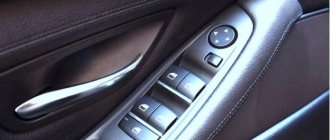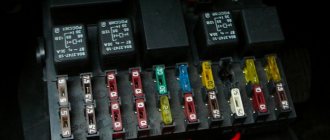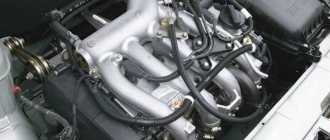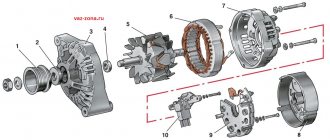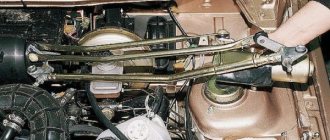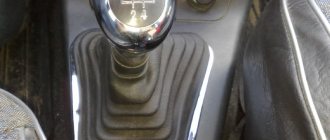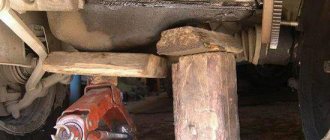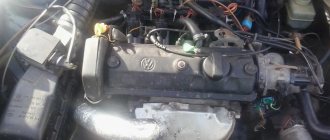Heater (stove) control circuit for VAZ-2110, 2111 and 2112
Heater (stove) control circuit for VAZ-2110, 2111 and 2112
The VAZ-2110, 2111 and 2112 are equipped with an automatic heater control system (AHCS), which itself creates the temperature in the car set by the driver. A kind of climate control without air conditioning, winter version. The brains of the system are controller 3 on a diagram of type 13.3854 with two control knobs. With the left knob we adjust the temperature in the cabin (from 16 to 30 °C), with the right knob we adjust the fan: 0 - off; I - average rotation speed; II - low rotation speed; A - automatically. So, here is a breakdown of the VAZ-2110 heater circuit
1 — fan electric motor; 2 - additional resistor; 3 - controller; 4 — mounting block; 5 — ignition switch; 6 — cabin air temperature sensor; 7 — recirculation switch; 8 — recirculation valve; 9 — micromotor gearbox for heater damper drive; A - to the instrument lighting switch; B - to power supplies
If the heater motor stops working, you should check fuse F18 in the mounting block
SAUO controllers (automatic heater control system). The one on the left - with automatic mode - is a primitive climate (it is tied to a temperature sensor under the ceiling). On the right is the more common 4-speed. When connected, they are compatible with the standard wiring of the VAZ 2110, with the exception of the misalignment of the MMR sensor (you just need to transfer + - on it).
Troubleshooting
Standard situation: the fan operates in all provided modes, but the heater only blows cold or hot air. In this case, you can conduct a fairly simple test. Turn on the ignition, turn off the heating fan and move the interior temperature control knob to the extreme left (minimum) or extreme right (maximum) position. In this case, you can determine by ear whether the micro-gearbox is working.
If it works, the heater fan is turned on at its fastest speed, and the temperature control is again moved to the far left and far right positions, allowing it to run in each of them for a few seconds. In this case, the sound of the air flow should change; if this is not the case, then this indicates a mechanical break in the connection between the electric motor and the damper or its jamming in one position. This will require further disassembly of the system and restoration of the functionality of the damper.
Heater (stove) control circuit for VAZ-2110, 2111 and 2112
The VAZ-2110, 2111 and 2112 are equipped with an automatic heater control system (AHCS), which itself creates the temperature in the car set by the driver. A kind of climate control without air conditioning, winter version. The brains of the system are controller 3 on a diagram of type 13.3854 with two control knobs. With the left knob we adjust the temperature in the cabin (from 16 to 30 °C), with the right knob we adjust the fan: 0 - off; I - average rotation speed; II - low rotation speed; A - automatically. So, here is a breakdown of the VAZ-2110 heater circuit
- fan motor;
- additional resistor;
- controller;
- mounting block;
- ignition switch;
- cabin air temperature sensor;
- recirculation switch;
- recirculation valve;
- micromotor gearbox for heater damper drive;
A - to the instrument lighting switch;
B - to power supplies
If the heater motor stops working, you should check fuse F18 in the mounting block
SAUO controllers (automatic heater control system). The one on the left - with automatic mode - is a primitive climate (it is tied to a temperature sensor under the ceiling). On the right is the more common 4-speed. When connected, they are compatible with the standard wiring of the VAZ 2110, with the exception of the misalignment of the MMR sensor (you just need to transfer + - on it).
If you find an error, please select a piece of text and press Ctrl+Enter.
We recommend reading:
Privacy Overview
This website uses cookies to improve your experience while you navigate through the website. Out of these cookies, the cookies that are categorized as necessary are stored on your browser as they are as essential for the working of basic functionalities of the website. We also use third-party cookies that help us analyze and understand how you use this website. These cookies will be stored in your browser only with your consent. You also have the option to opt-out of these cookies. But opting out of some of these cookies may have an effect on your browsing experience.
Necessary cookies are absolutely essential for the website to function properly. This category only includes cookies that ensures basic functionalities and security features of the website. These cookies do not store any personal information.
Checking the automatic control system
Diagram of the automatic heater control system : 1 – fan electric motor;
2 – additional resistor; 3 – controller; 4 – mounting block; 5 – ignition switch; 6 – cabin air temperature sensor; 7 – recirculation switch; 8 – recirculation valve; 9 – micromotor gearbox for heater damper drive; A – to the instrument lighting switch; B – to power supplies Pinout of automatic control system :
The SAUO receives information from:
- – cabin air temperature sensor (No. 6), which has a built-in small-sized fan.
- – MMR (micromotor reducer) (No. 9), information about the position of the heater damper.
Damper control : Based on the received information and the set air temperature, the controller controls the position of the heater damper, sending appropriate signals to the damper drive micromotor.
Fan speed control : to obtain a low rotation speed (all but the last), an additional resistor (No. 2) is used, which has two spirals with resistance (0.23 and 0.82 Ohms). When both spirals are connected to the electric motor power supply circuit, the 1st fan rotation speed is ensured; if a spiral with a resistance of 0.23 Ohm is turned on, the 2nd speed is provided. When the electric motor is turned on without a resistor, the fan rotor rotates at the maximum 3rd speed (4100 min-1).
Adjusting the automatic control system
Place a regular mercury thermometer near the temperature sensor on the ceiling. Turn on the heater controller and set the fan control knob to position “A”, and set the temperature dial to 2C higher than the air temperature in the cabin. If, with the doors and windows closed, after 15 minutes the temperature in the cabin does not correspond to the set temperature, then the heater control unit should be adjusted.
To adjust, pull out the SAUO block from the socket and rotate the regulator on the left side of the controller:
- turn clockwise to increase temperature.
- turn counterclockwise to decrease.
Check the operation of the heating system again by repeating the above steps.
Heating and ventilation system on Lada Granta, design
- radiator;
- several air ducts: to the glass blower grilles, to the right, central and left deflectors;
- Control block;
- radiator cap;
- air duct;
- seal;
- stove body;
- a hole connecting the air duct to the rear passengers;
- fan;
- fan housing;
- damper drafts: recirculation, temperature controller, air flow distribution;
- Fan resistor is optional.
SAUO repair
Before repairing the SAUO VAZ 2110 unit, you should make sure that the problems with the stove are associated with it. To do this, you should connect a known working heater control unit (borrow from a friend or from a store). If there are no problems with the stove with the working unit of the automatic control system, then we try to find out what the reason is. If the obviously working unit of the automatic control system did not help, then the problem with the stove is somewhere else.
Remove the buttons next to the SAUO block. We take out the stove control unit. Set the controls to position 0 and remove, and then remove the front cover and glass from the latches. Unscrew 2 screws in front and 1 in back. We remove the board from the plastic case and check the integrity of all tracks, jumpers and resistors. In this example, a broken jumper was found. We solder it on one side and the other. Reassemble in reverse order. Now all speeds of the SAUO block work .
FAQ on the operation of the VAZ 2110 stove
1st oven speed does not work
- All heater fan speeds (except the last one) are connected through an additional heater resistor, which is located under the frill (wind flap). One of the reasons when the first speed of the heater does not work is a malfunction of this resistor. Depending on the ACS unit, this additional resistor varies:
RDO 2108-8101081 is used on the oldest SAUO units, which have only 2 speeds. (0 A 1 2).
RDO 2110-8118022-01 is installed on a modified heater until September 2003, the SAUO unit has 3 speeds (0 A 1 2 3). The most common malfunction in this resistance is that all stove speeds stop working, except maximum 3. The reason is that the thermal fuse is unsoldered (indicated by a red arrow), and is treated by soldering it in place. But if it is unsoldered later, you need to look in the direction of the motor, the motor takes a very large current (not lubricated, wear on the brush assembly, etc.).
RDO 2123-2118022 has been installed on the latest heaters since September 2003, the SAUO unit has 4 speeds and does not have an auto mode (0 1 2 3 4).
- In addition to a malfunction of the additional heater resistor, the problem may also be in the contacts of the heater control unit board. Often, due to high temperatures, the board becomes very hot and the contact is soldered off. Carefully examine all contacts on the boards, especially at the power supply points.
- Clean contacts.
Heater speed 2 doesn't work
- The reason is exactly the same as in the case when the first heater speed does not work.
3rd speed heater doesn't work
- If the 3rd speed is the last, then it works without resistance (directly). And the problem may be in the contacts of the ACS unit (stripped/crimped), or in the contacts on the board of the ACS unit.
- If you have a stove control unit with 4 fan speeds (0 1 2 3 4), then look for problems with the 1st stove speed.
4th oven speed does not work
- The reason is exactly the same as in the case when the third heater speed does not work.
The stove blows equally at speeds 1 and 2, that is, there is almost no difference between the first speeds, but at speed 3 it blows much stronger
- The reason is the additional heater resistor, it needs to be replaced.
The temperature on the heater control unit is not regulated or the heater fan does not work. Disassemble the ACS unit and carefully examine all tracks and contacts. If there are no visible defects, then you need to look for the cause in the part indicated in the photo.
- Another reason could be poor contact in the fuse box. On the back of the block there is a 6-terminal chip, the blue wire on it is to the fan. Perhaps it was burnt in this connector at the connection point. It is necessary to replace the chip and crimp the new connector. Remove the block, disassemble and solder the leg (perhaps it melted and became unsoldered due to heating).
ps If there are other solutions to problems with the operation of the stove , then leave comments, we will supplement the FAQ on the operation of the SAUO unit . By the way, malfunctions in the heater can be caused by other reasons.
What most often failed in the stove of your “ten”?
Tell me why the stove is not heating
Good night grant drivers, please tell me why the stove is not heating, it is blowing warm and not hot. Operating temperature 75¤. The radiator is the same on both the bottom and top. Is it a damper or a thermostat?
Similar articles
33 comments on “Tell me why the stove doesn’t heat up”
This, I'm afraid, is a heater radiator... It was the same crap.
Alexey, are you sure it’s not a thermostat?
And it’s definitely not a damper, because it’s not there.
Three options for you. 1. Air lock in the system 2. Something wrong with the pump 3. Heater radiator
Denis, I changed the pump not long ago.
Albert, the pump impeller can rotate, for example
Look how the return flows into the expansion tank. Just don't open the lid when the engine is hot.
Denis, it was like this before, I changed the belt and pump a month ago.
Or could it be that the thermostat does not open all the way?
Albert, maybe. But then the engine will warm up for a very long time, for example 20 minutes, and then completely cool down on the highway
Denis, look yesterday at idle the temperature went up to 85, but as soon as I started driving it dropped to 70
Albert, At 70 the stove should heat normally
Denis, are there different thermostats?
Albert, I don't know. But in theory they can differ in response temperature. And a lot of fakes. order from the dealer, they will deliver the factory one
Yes, yes, look, it blows equally on the right and left?
Albert, it could be the damper; in general, it is the only one that regulates the temperature. It just didn’t open all the way, it’s easy to check, from the driver’s side in the legs you can see how it walks, remove the cable from it and bring it all the way and you’ll immediately feel it. But first, check if the stove is clogged, I have a video on my page. There's only one there)
Design features of the VAZ-2110 stove control unit and the specifics of its DIY repair
High-quality operation of a car’s heater in winter is one of the main conditions for comfortable driving. In domestic vehicles, even in new models, the heater is one of the problematic elements that very often fails. And if in the summer you can turn a blind eye to this, then in cold weather you immediately have to take measures to eliminate the problem.
To eliminate the malfunction, it is first important to diagnose which element of the car’s heating system has failed and repair the non-functioning unit. The easiest way is to turn to specialists for help, but their services are not very cheap. Very often, vehicle owners troubleshoot and repair the heater on their own, since domestic cars are highly maintainable.
This article will talk about how to diagnose a malfunction of the VAZ-2110 heater control unit and repair it yourself.
Why is it cold in Grant
Introduction
Lada Granta is a domestic car produced to this day. Granta is one of the affordable cars on the market and meets all the requirements for ensuring comfort for passengers and the driver. This car is equipped with air conditioning and climate control, although not full, but with a hint of it. With the onset of cold weather, it happens that the stove in Grant begins to blow cold air, and in order to find and eliminate the cause, you can spend a lot of effort without knowing the essence of the design and the causes of this breakdown.
This article will talk about the reasons why the stove in Grant blows cold air. After reading the article, you can easily find the cause of the breakdown and fix it.
Possible causes of failure
There are several similar reasons why the interior heater suddenly or after summer begins to work ineffectively. Below is a list of reasons:
- The antifreeze level has dropped;
- Cabin filter clogged;
- Heater radiator clogged;
- The expansion tank cap is faulty;
- Thermostat jammed;
- Damper jamming;
To understand each possible reason, it must be considered individually.
Antifreeze level drop
The amount of antifreeze directly affects the operation of the heater. If the level in the expansion tank drops, the cooling system may catch an air lock during circulation, which will lead to insufficient heating of the heater radiator and, consequently, to insufficient heating of the interior in cold weather.
It is necessary to check the antifreeze in the engine compartment of the car; to do this, you need to look at the expansion tank and the liquid in it should be between the MIN and MAX marks. If the level is insufficient, the coolant must be added, observing the color of the antifreeze.
Cabin filter
The cabin filter is responsible for the frequency of the air ducts, protecting the fans and radiator from contamination. Often, many car owners remove the cabin filter to create a more powerful air flow from the air ducts, which soon leads to contamination of both the air ducts and the radiator with fan.
If there is a weak air flow from the heater, then most likely the cabin filter or heater radiator is dirty.
Heater radiator
The radiator is the heart of the stove in a car, it is it that gives off heat to heat the interior; the hotter the radiator heats up, the warmer it will be in the cabin. When the radiator becomes clogged, heat is transferred much worse due to poor fluid circulation through the system.
Radiator clog can be of two types: internal and external.
Blockage outside
Such blockage most often occurs due to the absence of a cabin filter or due to its long use without replacement. This problem can be resolved by removing and washing the radiator.
Blockage from inside
The blockage that forms from the inside is due to the accumulation of oxides formed due to the oxidation of aluminum. Also, if the antifreeze is not changed for a long time, it can deteriorate and precipitate, which will soon clog the radiator.
Check the radiator for clogging from the inside, you can assess the reliability of fluid circulation through it. To do this, you need to touch the hoses that go to the radiator; they should both be hot. If any of them are cold, the radiator is clogged and needs to be washed.
Extender cap
The expander cap is a reliable element, but it can also fail and impede the circulation of fluid through the system by creating a vacuum. The lid is a valve that opens and closes as necessary to supply the expander with air, which helps prevent vacuum from forming in the system. If the valve jams, a vacuum will be created in the system, which will lead to poor fluid circulation and insufficient heating of the interior.
Thermostat
One of the most important elements of the SOD is the thermostat. It is he who is responsible for the temperature of the coolant. A working thermostat heats the coolant to a temperature of 85°C. If it is jammed in the open position, the coolant will constantly circulate through the cooling radiator, preventing the car from warming up, which will lead to a low coolant temperature and, consequently, insufficient heating of the interior in cold weather.
The damper in modern cars is controlled both by actuator and mechanically. It happens that the damper gets stuck in the open position and directs the air flow past the radiator, which produces cold air at the outlet of the air ducts.
Design features of the VAZ-2110 stove control unit
One of the common heating system problems that VAZ-2110 owners encounter is the failure or malfunction of the heater control unit. Dozens of them are equipped from the factory with stoves, which are coordinated through an automatic heater control system. In short, the system is called the SAUO block. The main indicators of its malfunction are the operation of the heating system not in all modes. If one or more stove speeds do not work, then most often the problem is in the ACS unit. Thanks to the electronic module of the VAZ-2110, the temperature set by the driver is maintained in the car interior.
Before you begin repairing the VAZ-2110 heater, you need to find out what kind of heater is on your vehicle. Cars that were produced before September 2003 are equipped with old-style stoves. Accordingly, there are significant differences in the design, which are important to pay attention to during repairs.
The ACS unit consists of electronic elements, which are coordinated using handles on the central console of the machine.
The VAZ-2110 stove control unit is equipped with a controller with two handles. The right handle is responsible for turning on a certain fan speed. An additional resistor is directly responsible for switching its speeds. Old style stoves have resistors for two or three fan speeds. The new model stoves have a modified resistor RDO 2123–2118022. The unit for coordinating the operation of the improved stove model has four speeds and does not have an auto mode.
The left handle is responsible for turning on the temperature mode in the vehicle interior. Depending on the position of the handle, information about the set air temperature is supplied to the micro-reducer of the damper drive and, using the controller, the required position of the damper is set. Using the regulator, you can set the temperature from sixteen to thirty degrees Celsius.
Until 2003, cars were equipped with old-style stoves with four- and five-position controllers, which are now out of production and are very difficult to find. Also, the simple VAZ-2110 heater control unit is not suitable for car models that were produced after 2003 and are equipped with modified stoves from the factory.
Accordingly, before buying parts to repair the heating system of a vehicle, you need to look in the technical documentation to find out which heater model is on your top ten. The stoves differ not only in the ACS unit, but also in the heater radiator, micro-reducer, and resistors.
Introduction
The heating device, which is installed in the domestic VAZ-2110, is a separate system consisting of several devices. The main element of the design is the unit, the functioning of which determines the preparation of the air flow entering the vehicle interior. The stove block is located under the hood of the car, with its help the speed at which the air flows, as well as its temperature, is adjusted. In addition to the central unit, the system includes an air distributor. It is worth noting that all the air ducts that are on the VAZ-2110 are located inside the car on the instrument panel. The Volga "ten" is equipped with a special stove "2110-01", which differs from other models in the presence of an evaporator in the standard climate control device. In the article we will look at the reasons why the VAZ-2110 stove mode switch does not work, and we will also provide instructions for troubleshooting problems that have arisen in each of the units.
Diagnostics of serviceability and dismantling of the stove control unit
The SAUO module is located on the center console of the car and is responsible for proper heating of the interior. Repairing the VAZ-2110 stove control unit requires certain knowledge in electronics, so before you begin repairing the part, you need to determine whether the problem is really in the electronic module itself.
To do this, you must initially dismantle the unit and install a known-good part in its place. Take the SAUO unit from friends or at a service center to diagnose the heating system of your car.
Before performing any work on the vehicle that involves electronics or wiring, turn off power to the battery to avoid shorting or burning out the electronic components.
Then you can proceed directly to removing the unit through which the functionality of the stove is coordinated. To do this, the buttons that are located on the sides of the stove are initially dismantled. The heater controls must be switched to zero positions. Only then can the module be pulled out. This must be done very carefully, since the power plugs are connected to the back of the unit. As soon as you see them, they must be carefully disconnected so as not to damage the contacts. At this point, dismantling can be considered complete.
The working unit is installed on the standard seat, and the operation of the vehicle’s heating system is checked. If the stove functions correctly with the new unit, then the fault is in the ACS unit itself. Otherwise, it is necessary to diagnose other elements of the heating system.
Removing the temperature controller
To repair or replace the stove temperature regulator, you need:
- Unscrew and move to the side one of the climate dampers located under the steering wheel of the car.
- Next, the pedal assembly, consisting of the brake pedal and gas pedal, is dismantled. The wiring harness is disconnected from the assembly, and the connectors are disconnected from the pedals.
- Two connectors are unfastened from the heater regulator, and its contacts are diagnosed - maybe they are oxidized or burnt.
- At the final stage, the temperature regulator is unscrewed, which is held on by a pair of screws.
This completes the work on removing the regulator.
Source
DIY repair of the VAZ-2110 heater control unit
If during diagnostics it turns out that the problem is in the heater control module, then you need to try to repair it or install a new part. Since the price of new electronic units is quite high, the right decision would be to repair the control part, especially since this requires only basic knowledge of electronics, the ability to use a tester and a soldering iron if necessary.
Before you begin, you need to disassemble the heater control unit. To do this, the front cover with regulators is removed from the latches from the previously dismantled electronic module. Next, a special glass cover is detached. Using a screwdriver, unscrew two screws on the front panel of the unit and one on the rear wall. After this, the top cover of the module can be removed; this must be done very carefully so as not to damage the contacts inside the part.
Inside the module there are electronic tracks, contacts and resistors that are responsible for the high-quality functioning of the vehicle’s heating system controllers. It is necessary to inspect all contacts, electronic tracks on the board, resistors and jumpers. High operating temperatures can cause the board to become very hot, which will lead to disconnection of the contacts. Particular attention should be paid to the power supply points and the contacts should be cleaned. If there is visible damage to the electronic circuit, it is necessary to solder the damaged elements. In parallel, using a tester and an ohmmeter, the functionality of the electronic elements and resistors located on the board is checked. If necessary, non-functioning parts on the ACS module board are replaced.
After troubleshooting, the heater control unit is assembled in the reverse order and installed in its original place. Next, you need to connect the battery power and check the operation of the vehicle’s heating system; if necessary, adjust the heater controller.
Adjusting the stove controller
The manufacturing plant provides for heating the interior to the specified temperature in fifteen minutes with a deviation of up to two degrees. Use the controller knob to set a comfortable temperature in the car interior.
To check the proper functioning of the stove, use a regular mercury room thermometer. If after fifteen minutes the interior has not warmed up to the required temperature, the controller must be adjusted.
To do this, pull the heater control module back out and rotate the temperature regulator, first to the maximum value, then in the opposite direction. After carrying out such actions, install the unit in place and check the operation of the stove again.
At the same time, it is necessary to check the operation of the heater dampers. If there are extraneous sounds when switching temperature modes, then you need to check the condition of the dampers. If cold air flows well, but hot air hardly flows in, then the lower damper is faulty. If there is no normal flow of cold air but there is a good flow of hot air, there is a problem with the upper damper. The reason may be deformation of the dampers under the influence of air of different temperatures. In this case, it is better to replace the standard plastic dampers with aluminum analogues, which are more resistant to temperature changes.
After adjusting the controller, all heater elements are installed in their original places. Assembly is carried out in reverse order.
Let's sum it up
Malfunctions of the VAZ-2110 heater control unit can lead to both incorrect functioning of the vehicle’s heating system and complete failure of the heater. During the cold season, this will affect not only a comfortable stay in the car, but also safe driving for the driver of the vehicle.
Repairing the stove control unit can be done on your own if you have basic knowledge of electronics, a desire to work and improve your comfort.
High-quality repairs and timely regular inspections of the unit before the onset of cold weather will help you save money on stove repair services at service centers and the purchase of expensive heating system elements.
Causes of unit malfunction
Engineers began to use a similar method of adjusting temperature and air direction back in the early decades. Since then, this system has been improved, and is already used on new models of the AvtoVAZ plant. Despite its rather simple design, the stove control unit periodically fails. There are several reasons for this:
- damage to mechanical parts in the structure;
- break in the power supply circuit of the unit;
- damper jamming.
To repair or replace the unit, you will need to dismantle the faulty module. For its time, this stove control design was considered truly innovative (at least for domestic cars), while now it fails more and more often. Repairing a block is not the easiest procedure, so more often than not, owners of cars of the “ten” family with such a problem change the block assembly.

